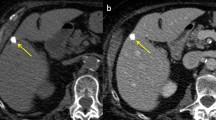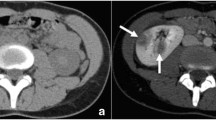Abstract
Objectives
To investigate the added advantage of IV furosemide injection and the subsequent urine dilution in the detection of urinary calculi in the excretory phase of dual-source dual-energy (DE) computed tomography (CT) urography, and to investigate the feasibility of characterising the calculi through diluted urine.
Methods
Twenty-three urinary calculi were detected in 116 patients who underwent DECT urography for macroscopic haematuria with a split bolus two- or three-acquisition protocol, including a true unenhanced series and at least a mixed nephrographic excretory phase. Virtual unenhanced images were reconstructed from contrast-enhanced DE data. Calculi were recorded on all series and characterised based on their X-ray absorption characteristics at 100 kVp and 140 kVp in both true unenhanced and nephrographic excretory phase series.
Results
All calculi with a diameter more than 2 mm were detected in the virtual unenhanced phase and in the nephrographic excretory phase. Thirteen of these calculi could be characterised in the true unenhanced phase and in the mixed nephrographic excretory phase. The results were strictly identical for both phases, six of them being recognised as non-uric acid calculi and seven as uric acid calculi.
Conclusions
Mixed nephrographic excretory phase DECT after furosemide administration allows both detection and characterisation of clinically significant calculi, through the diluted urine.
Key points
• Urinary tract stones can be detected on excretory phase through diluted urine.
• Urinary tract stone characterisation with dual-energy CT (DECT) is possible through diluted urine.
• A dual energy split-bolus CT urography simultaneously enables urinary stone detection and characterisation.


Similar content being viewed by others
References
Cowan NC (2012) CT urography for hematuria. Nat Rev Urol 9:218–226
Takahashi N, Hartman RP, Vrtiska TJ et al (2008) Dual-energy CT iodine-subtraction virtual unenhanced technique to detect urinary stones in an iodine-filled collecting system: a phantom study. AJR Am J Roentgenol 190:1169–1173
Ascenti G, Siragusa C, Racchiusa S et al (2010) Stone-targeted dual-energy CT: a new diagnostic approach to urinary calculosis. AJR Am J Roentgenol 195:953–958
Graser A, Johnson TR, Bader M et al (2008) Dual energy CT characterization of urinary calculi: initial in vitro and clinical experience. Invest Radiol 43:112–119
Manglaviti G, Tresoldi S, Guerrer CS et al (2011) In vivo evaluation of the chemical composition of urinary stones using dual-energy CT. AJR Am J Roentgenol 197:W76–W83
Wang J, Qu M, Duan X et al (2012) Characterisation of urinary stones in the presence of iodinated contrast medium using dual-energy CT: a phantom study. Eur Radiol 22:2589–2596
Takahashi N, Vrtiska TJ, Kawashima A et al (2010) Detectability of urinary stones on virtual nonenhanced images generated at pyelographic-phase dual-energy CT. Radiology 256:184–190
Mangold S, Thomas C, Fenchel M et al (2012) Virtual nonenhanced dual-energy CT urography with tin-filter technology: determinants of detection of urinary calculi in the renal collecting system. Radiology 264:119–125
Karlo CA, Gnannt R, Winklehner A et al (2013) Split-bolus dual-energy CT urography: protocol optimization and diagnostic performance for the detection of urinary stones. Abdom Imaging 38:1136–1143
Scheffel H, Stolzmann P, Frauenfelder T et al (2007) Dual-energy contrast-enhanced computed tomography for the detection of urinary stone disease. Invest Radiol 42:823–829
Segura JW, Preminger GM, Assimos DG et al (1997) Ureteral Stones Clinical Guidelines Panel summary report on the management of ureteral calculi. The American Urological Association. J Urol 158:1915–1921
Lallas CD, Liu XS, Chiura AN, Das AK, Bagley DH (2011) Urolithiasis location and size and the association with microhematuria and stone-related symptoms. J Endourol 25:1909–1913
Ciudin A, Luque Galvez MP, Salvador Izquierdo R et al (2012) Unenhanced CT findings can predict the development of urinary calculi in stone-free patients. Eur Radiol 22:2050–2056
Liden M, Andersson T, Broxvall M, Thunberg P, Geijer H (2012) Urinary stone size estimation: a new segmentation algorithm-based CT method. Eur Radiol 22:731–737
Eiber M, Holzapfel K, Frimberger M et al (2012) Targeted dual-energy single-source CT for characterisation of urinary calculi: experimental and clinical experience. Eur Radiol 22:251–258
Moran ME, Abrahams HM, Burday DE, Greene TD (2002) Utility of oral dissolution therapy in the management of referred patients with secondarily treated uric acid stones. Urology 59:206–210
Xu H, Zisman AL, Coe FL, Worcester EM (2013) Kidney stones: an update on current pharmacological management and future directions. Expert Opin Pharmacother 14:435–447
Nakada SY, Hoff DG, Attai S, Heisey D, Blankenbaker D, Pozniak M (2000) Determination of stone composition by noncontrast spiral computed tomography in the clinical setting. Urology 55:816–819
Nolte-Ernsting C, Cowan N (2006) Understanding multislice CT urography techniques: Many roads lead to Rome. Eur Radiol 16:2670–2686
Metser U, Goldstein MA, Chawla TP, Fleshner NE, Jacks LM, O'Malley ME (2012) Detection of urothelial tumors: comparison of urothelial phase with excretory phase CT urography—a prospective study. Radiology 264:110–118
Kekelidze M, Dwarkasing RS, Dijkshoorn ML, Sikorska K, Verhagen PC, Krestin GP (2010) Kidney and urinary tract imaging: triple-bolus multidetector CT urography as a one-stop shop–protocol design, opacification, and image quality analysis. Radiology 255:508–516
Kaza RK, Platt JF, Cohan RH, Caoili EM, Al-Hawary MM, Wasnik A (2012) Dual-energy CT with single- and dual-source scanners: current applications in evaluating the genitourinary tract. Radiographics 32:353–369
Ascenti G, Mileto A, Gaeta M, Blandino A, Mazziotti S, Scribano E (2013) Single-phase dual-energy CT urography in the evaluation of haematuria. Clin Radiol 68:e87–e94
Author information
Authors and Affiliations
Corresponding author
Rights and permissions
About this article
Cite this article
Botsikas, D., Hansen, C., Stefanelli, S. et al. Urinary stone detection and characterisation with dual-energy CT urography after furosemide intravenous injection: preliminary results. Eur Radiol 24, 709–714 (2014). https://doi.org/10.1007/s00330-013-3033-5
Received:
Revised:
Accepted:
Published:
Issue Date:
DOI: https://doi.org/10.1007/s00330-013-3033-5




